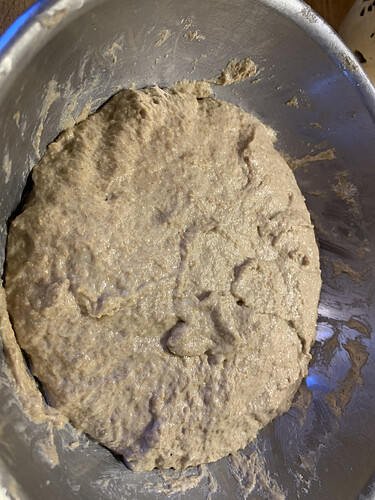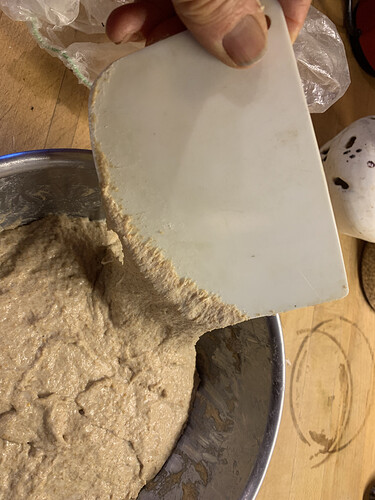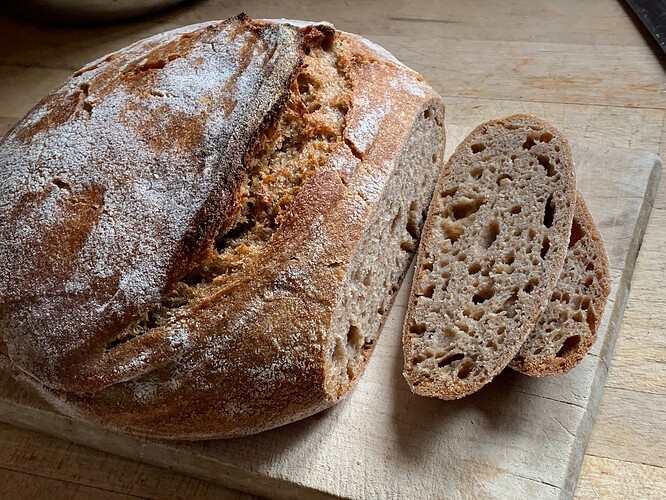I use 100% whole wheat flour ground once through a Mockmill 100 for 66% hydration sourdough. I can’t stretch and fold, as dough is sticky. If I increase hydration, dough becomes a gooey mess. Any suggestions? #baking-techniques
Have you tried letting the shaggy mass of dough sit covered for an hour before attempting to do stretch and folds? Then even if sticky, wet your hand and start stretch and folds at half hour intervals to see if the dough texture improves. I do this with my home milled blend of hard red, spelt and rye with an 80-85% hydration and don’t have the problem you’re describing.
Actually, the dough is never shaggy. Just very stick. I am able to work with it by wetting my hands repeatedly, but that’s mostly to knead and try and stretch and fold.
I’m surprised you can do it with any rye flour in the mix at all. I’ve always found it extremely sticky and religiously avoid using it.
Fineness of the grind is a factor. Perhaps your mill grinds finer than the Mockmill 100. What is your mill?
My mill is a Mockmill Pro 100. I do wonder if I’m milling finer than you. Do you pour the grains in the hopper right when you start hearing the stones grinding? I pay no attention to the dots, only what I hear. The start point has shifted over time so the dots have little meaning. (Actually, not sure your model has dots but either way you should hear the stones grind.)
My shaggy mass is just when I see no more flour. The higher the hydration, the easier it is to do this. Sometimes I don’t even use my hand, just a utensil of some sort. But whatever I use, it’s a sticky mess before I cover and leave for an hour.
You’re right about rye but in this blend I use a very small amount: 5%. Wheat (hard red or hard white or a combo) is 65% and spelt is 30%. It’s a tasty blend.
Thanks for the quick response. I do the same as you, move the Mockmill slider until very slightly after I hear the stones touching. (I separate the stones after each milling, thinking it might let any gunk remaining drop off.) I adjust the slider and then pour all the grain into the hopper.
I actually autolyze the flour anywhere from 2 to 12 hours before mixing it with the levain. Both autolyze and levain are 65% hydration.
Seems like something else must be going on. I would be able to do nothing else with my hands with the flour if mine was 85% hydration.
Ok, so the grind doesn’t seem to be the problem. The long autolyze sounds unusual. Why not try skipping it and just mix flour, water, levain and salt, wait an hour and see how it feels. I know adding salt and starter at the same time goes against the “rules” but it works fine for me. I get really nice results. Sounds like your frustration is such that it can’t hurt to try!
I’ll give that a try and report back.
I’m debating whether to up to 75%, perhaps even higher, just to see fi the shaggy method works for me. Or to keep hydration at 66% hydration just to make sure of results.
Maybe for your first try you should keep the hydration the same as you’re used to. Then you’ll have a better sense if the problem was the long autolyze.
So I went whole hog with 85% hydration. I did repeated stretch and folds, as best as I could with the dough, which was goopy, even pourable. I’ll try to get it into the banneton, putting plenty of rice flour on the cloth to prevent – I hope – sticking. I thought that by this stage the dough would not be sticky. Any suggestions?
Yikes! 85% was probably overkill. I think your usual 66% would tell a better story. But for this one, you could always bake it in a pan to give it structure. I’m hoping someone else on the forum can come up with other suggestions. Just brainstorming here: I’m assuming you use salt, 2%? Do you have another source of wheat berries you could try? Are the ones you’re using sprouted by any chance? I know sprouted wheat flour can affect the results although I’ve never really used it.
Something I forgot to ask: are your wheat berries hard wheat?
I use Renan hard red winter wheat berries. The bread came out perfectly!!! Good texture, flavor, and crust. Thanks
I was surprised the dough didn’t collapse in the dutch oven.
I am going to try lowering the hydration to 75% or 80% to see if, using your method, I get a dough that I can handle. I never touched it except to grab and fold – quickly and with wetting hand. Perhaps more folds would develop the dough more.
That looks really nice! I’m so glad. You obviously had no trouble getting it out of the banneton. Rice flour really works great. It would be nice to have a dough that’s easier and more enjoyable to handle so I agree lowering hydration would be worth a try.
Today I was about to prep my usual bread blend and decided to do all wheat instead, just to see. Half hard red, half hard white. I tried 80% hydration but had to add some water because the mixer (just started using a mixer; always did it by hand until recently) made it seem too stiff. I just shaped it and it was a beautiful texture. I use wet counter and hands instead of floured. Not a bit of dough on my hands, just moisture! Really nice to work with. We’ll see how it bakes tomorrow.
I’m still trying to figure out what makes such a difference. You mentioned your mill is the Mockmill PRO 100; mine is the Mockmill 100. I don’t see anything called Mockmill PRO 100 although there is a Mockmill Professional 200.
Do you do any sifting of your milled grain?
What kind of mixer do you use? Except for this last loaf, I would mix up the autolyze for just 4 minutes in my Pnasonic breadmaker, and then use it again fo r4 minutes to mix the autolyze and levain. From then on, it’s by hand.
It looks like they don’t make the Pro 100 any more from what I see. Mine is about five years old. No, I don’t do any sifting. I recently got an Ankarsrum mixer (used!). I previously had an old Kitchen Aid that I used rarely. Since it’s new to me to knead by machine, I haven’t drawn any conclusions yet. It’s definitely easier for mixing the dough but I’m not sure yet if kneading fir 12 minutes replaces the stretch and folds that I did before. I also make rye breads a lot (80-100% rye) and am looking forward to trying those in the new mixer. Good idea to mix in a bread machine. I hadn’t thought of that.


